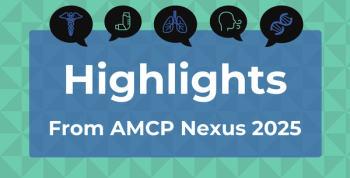
Treatment of Newly Diagnosed Symptomatic Myeloma and Dosing Regimens
The expert reviews the standard for treatment of newly diagnosed symptomatic myeloma. He also reviews the different dosing regimens used.
Transcript
Ajai Chari, MD: The question of what regimen to use for newly diagnosed symptomatic myeloma is a really important one. We don’t see in any single study that the median overall survival or the overall survival Kaplan-Meier curves is flat. We continually lose patients, so we haven’t cured patients. The most vulnerable are probably high-risk patients who are frail and older, have renal failure, and don’t improve. In these patients, there’s this thought sometimes people have, “I want to save my drugs for later.”
When we think about when to use our most potent drugs, there’s this concern that if we use our good drugs early, what will we use in relapse? The response to that are the concepts of attrition and diminishing returns. If you start with 1000 newly diagnosed patients, we know that no study has shown that the survival curves are flat. People will unfortunately die continually, and those are particularly the frail, older patients with renal failure, who don’t recover their kidneys, and high-risk patients. These groups in particular may not be able to get to that first relapse to have access to these novel drugs. That’s an important concept, which is attrition.
The second concern is that whenever we look at response rates and PFS [progression free survival], there are diminishing returns. Our deepest remissions and most durable remissions are in the first treatment, followed by the first relapse, second relapse, and progressively downward. If we want to get the maximum bang for our buck, it’s important to use these drugs early. However, it doesn’t mean that every patient needs to get every drug forever. I think the point is we start with aggressive therapies and then we can try to maintain these patients on the minimal number of drugs that patient needs, based on the patient and disease profile.
In terms of the transplant-eligible population, the discussion of RVd [bortezomib, lenalidomide, dexamethasone] versus KRd [carfilzomib, lenalidomide, dexamethasone] is an important one. Certainly, KRd, based on the FORTE study, shows dramatic results with excellent MRD [minimal residual disease] negativity. There were 2 parts of FORTE. One was the KCd [carfilzomib, cyclophosphamide, dexamethasone] versus KRd, and we discussed that the KRd was superior. But the other question being asked in FORTE was KRd for a year versus KRd with transplant consolidation. And there the initial responses looked comparable, showing the potency of this drug.
The only consideration is we have no head-to-head studies yet for KRd versus VRd [bortezomib, lenalidomide, dexamethasone], or K [carfilzomib] versus V [bortezomib], other than the fact that we have ENDEAVOR, which is bortezomib 1.3 mg/m2 twice weekly compared with carfilzomib at 56 mg/m2 twice weekly. But the problem is that you can’t use 56 mg/m2 with a concurrent IMiD [immunomodulatory imide drug] because of cardiopulmonary concerns. And so the question becomes, if you’re going to do VRd and KRd where you do have an IMiD, what is the relative head-to-head comparator? We don’t have that answer.
The other challenge with head-to-head comparisons is even if we look at induction and consolidation, KRd is typically given over a 28-day cycle versus how VRd is typically 21-day cycles. Even when we say 6 cycles, the amount of chemotherapy that a patient is getting is different. When we think about all that complexity, there is not 1 right answer, and there are also patient and physician preferences. Both are really good options and can be used on label.
There are many different dosing regimens for carfilzomib, and initially it was approved at 20 mg/m2 and 27 mg/m2, so 20 mg/m2 was day 1 and 2 followed by 27 mg/m2 on day 8, 9, 15, 16, and thereafter. This showed a response rate in PFS in the heavily treated patient population of approximately 25%, 3 to 4 months. Then the ARROW study was done to essentially look for convenience, and the question is if you give carfilzomib at 70 mg/m2 once weekly versus the 20 mg/m2 and 27 mg/m2, is there a difference?
What I find interesting about this study is what was initially designed as a convenience study looking at weekly versus twice-weekly dosing ended up showing not only that it’s obviously a convenient regimen but also a better response rate in PFS. Of course, some of that comes from the fact that the cumulative dosage administered is going to be higher, 70 mg/m2 over 3 weeks is actually 210 mg. When we compare those different regimens, it’s important to look at not only the weekly dosing but also the cumulative monthly dosing. Clearly, ARROW shows that as the single agent, 70 mg/m2 weekly is the preferred dosing schedule.
There are other doses and schedules that are also approved. The next carfilzomib single-agent approval is the ENDEAVOR study, which is carfilzomib at 56 mg/m2, and that’s on a twice-weekly schedule, days 1, 2, 8, 9, 15, 16. When that was compared head to head with bortezomib, it showed again superior response rates in PFS. Recently, it translated into OS [overall survival] benefit. If somebody is using just carfilzomib, that’s also a very powerful regimen and that would probably be the most potent regimen without a third drug.
The complexity comes in, what do you do when you’re adding a third drug? I think it depends on what the third drug is. For example, if you’re using a monoclonal antibody, such as daratumumab, we published in Blood that you can give it safely at 70 mg/m2, with standard dosing. That is now listed by the NCCN [National Comprehensive Cancer Network Guidelines] as an option for relapsed disease.
When it comes to cyclophosphamide, recent data presented from the United Kingdom by Kwee Yong, known as the Cardamon study, also looked at the use of carfilzomib at 56 mg/m2 twice weekly with cyclophosphamide, so that is another option as well. The main concern comes when you use an IMiD. If you’re combining carfilzomib with either lenalidomide or pomalidomide, and likely thalidomide as well, there is going to be a higher rate of cardiac and pulmonary issues and thrombotic events.
For those patients, it is probably better not to go more than 56 mg/m2 weekly, and that is what several studies that have been discussed at this year’s ASH [American Society of Hematology] 2019 Annual Meeting & Exposition did. That includes Dr Luciano Costa’s MASTER study as well as Dr Ola Landgren’s study, and both studies used carfilzomib at 56 mg/m2 once a week—days 1, 8, and 15—in combination with lenalidomide. They also used, of course, daratumumab, but I think the principle is that carfilzomib with an IMiD should probably not be given more than 56 mg/m2 once weekly. One other option that patients can receive with concurrent IMiD would be carfilzomib 36 mg/m2 twice weekly, so days 1, 2, 8, 9, 15, 16. That has also been shown to be safe and effective. But if it’s going to be weekly, it would be better capped at 56 mg/m2.
Newsletter
Stay ahead of policy, cost, and value—subscribe to AJMC for expert insights at the intersection of clinical care and health economics.







































